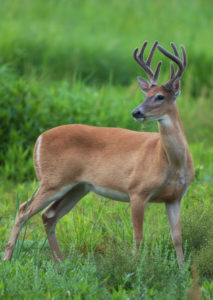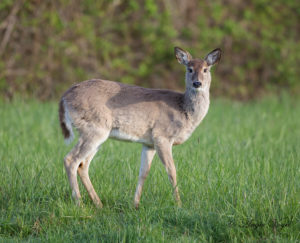 Columbian White-tailed Deer
Columbian White-tailed Deer
Odocoileus virginianus leucurus
The Columbian white-tailed deer is named after the Columbia River in Oregon and Washington. It is the westernmost subspecies of white-tailed deer in North America and can be distinguished from other types by its large size. They can be found along the lower Columbia River in southwest Washington and western Oregon, and typically live in and near riparian areas.
Columbian white-tailed deer feed on cottonwood, young willow, alder and other deciduous trees on the banks of rivers and surrounding lands, where they spend the majority of their time. The riverside underbrush also offers the deer protection from predators. Males are much larger than females, with an impressive pair of antlers that they shed each winter and regrow in early spring. Both sexes have a white underside to their tails, which is how they got their name. They prefer to graze on young, shorter grasses and forbs that are more attractive and nutritious.
Females often gather in family groups ranging from 2-12 individuals, whereas males are usually seen alone.
Breeding activity, known as the rutting period, begins in early November and lasts about a month. Females, called does, have a gestation period of approximately 210 days, with the peak in mid-to-late June. The female typically gives birth to one or two fawns, but can occasionally have three or even four! The fawns stay with their mother until just before the next fawning season, when the doe will seclude herself to give birth to another group of fawns.
Columbian white-tailed deer were classified as an endangered species under the Federal Endangered Species Act in 1968, but in late 2016, the U.S. Fish & Wildlife Service reported that the Columbia River population has been downgraded from endangered to threatened. This reclassification gives landowners, states and tribes more flexibility in managing the deer populations, which, according to the U.S. Fish & Wildlife Service, can lead to greater populations and distribution throughout their natural range.
The federally-owned Julia Butler Hansen Refuge for the Columbian White-Tailed Deer, located in Cathlamet, Washington, offers critical habitat protection for these deer. Currently, about 300 Columbian white-tailed deer are protected on the Refuge.
The recovery of the Columbian white-tailed deer included the relocation of more than 80 Columbian white-tailed deer from the Julia Butler Hansen Refuge for the Columbian White-tailed Deer to the Ridgefield National Wildlife Refuge. Visitors have reported seeing both adults and young white-tailed deer throughout the Refuge’s public areas. Deer that have been relocated will have bright yellow ear tags and the adults are often fitted with radio collars for studying their activity. However, those young that are born on the Refuge will not have either of these.
Early records reveal that these deer were once quite numerous. This subspecies of white-tailed deer became endangered due to habitat changes by human activities, such as farming, logging and development, and also by overhunting and poaching. However, protection under the Endangered Species Act has resulted in acquisition, protection, and improvement of habitat, which has allowed the population’s size to increase.
Did you know?
About 1 in 10,000 female Columbian white-tailed deer will have antlers.
The white underside of the deer’s tail is usually only visible when they raise their tails after sensing danger.
Columbian white-tailed deer can reach speeds of 36 miles per hour, and leap as far as 30 feet and 8½ feet high.
Photos: By Angie Vogel 1. Male 2. Female